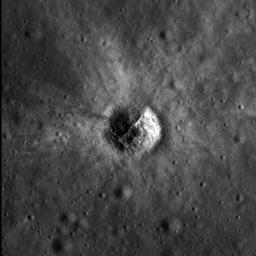
|
Bright Crater Rays and Boulders
- Click the image above for a larger view
- Full-Res JPEG (1000 x 1000) (109.6 kB)
- Full-Res TIFF (1000 x 1000) (1.0 MB)
Caption:
Small (250 m diameter) fresh impact crater surrounded by an asymmetrical bright ejecta blanket.
High reflectance ejecta usually indicates a young age for the crater's formation, or at least young for the Moon (less than 500 million years). Over time, ejecta blankets such as this will fade and disappear into the background. Since the ejecta is still relatively young, details of its shape are easily seen in this LROC image (1.1 meters per pixel). Close inspection of ejecta patterns help scientists determine dynamics of the impact event. In this case the "V" shaped gap in the bright ejecta shows the impactor came from the northwest at a very low angle.
The floor of the crater has numerous blocks as large as 13 meters that may be pieces of bedrock excavated from below the regolith (lunar soil); or they may have formed as a result of the impact. This type of boulder can be thought of as "instant rock," because under the extremely high pressure produced by an impact the loose regolith is consolidated into a coherent block or boulder. Apollo astronauts discovered these instant rocks (or regolith breccias) at several locations, with perhaps the most notable being Van Serg crater at the Apollo 17 landing site. Image is 1100 meters wide, north is up, subarea from uncalibrated NAC frame M103138324L.
Background Info:
NASA's Goddard Space Flight Center built and manages the mission for the Exploration Systems Mission Directorate at NASA Headquarters in Washington. The Lunar Reconnaissance Orbiter Camera was designed to acquire data for landing site certification and to conduct polar illumination studies and global mapping. Operated by Arizona State University, the LROC facility is part of the School of Earth and Space Exploration (SESE). LROC consists of a pair of narrow-angle cameras (NAC) and a single wide-angle camera (WAC). The mission is expected to return over 70 terabytes of image data.
Cataloging Keywords:
| Name | Value | Additional Values |
|---|---|---|
| Target | Moon | |
| System | Earth | |
| Target Type | Satellite | |
| Mission | Lunar Reconnaissance Orbiter (LRO) | |
| Instrument Host | Lunar Reconnaissance Orbiter | |
| Host Type | Orbiter | |
| Instrument | Lunar Reconnaissance Orbiter Camera (NAC) | |
| Detector | Narrow Angle Camera (NAC), Wide Angle Camera (WAC) | |
| Extra Keywords | Crater, Grayscale, Impact | |
| Acquisition Date | ||
| Release Date | 2009-08-03 | |
| Date in Caption | ||
| Image Credit | NASA/GSFC/Arizona State University | |
| Source | photojournal.jpl.nasa.gov/catalog/PIA12893 | |
| Identifier | PIA12893 | |
